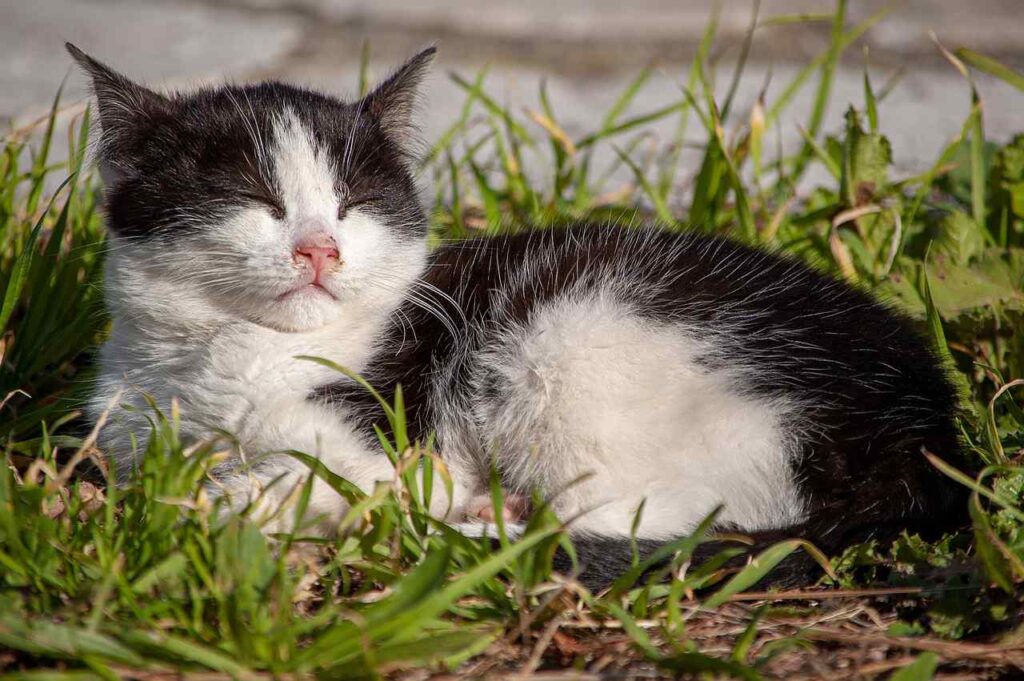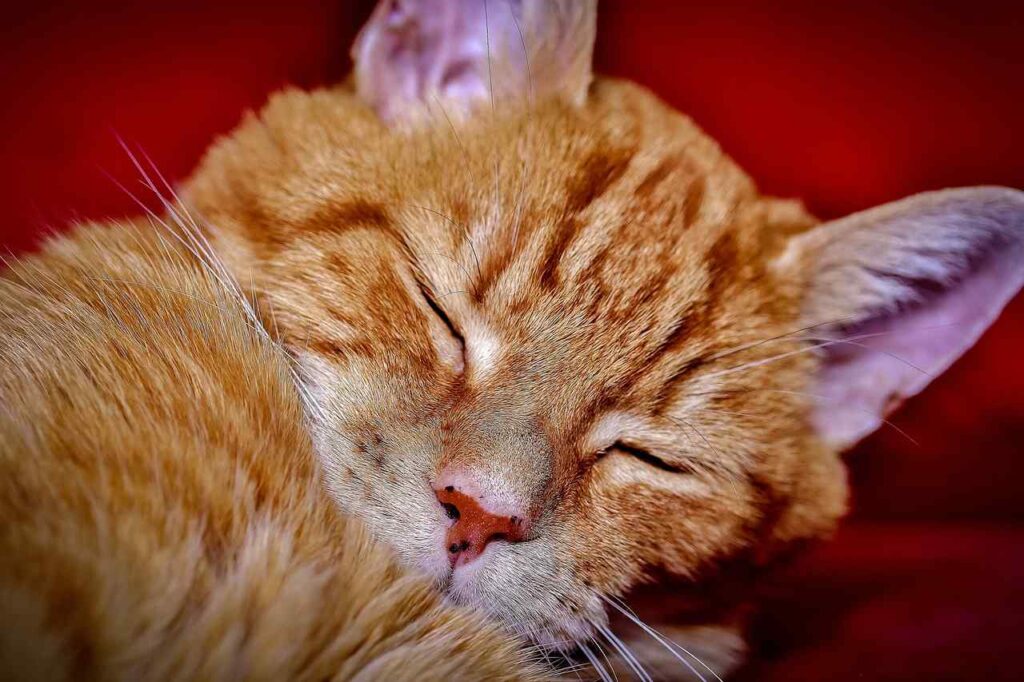Table of Contents
Have you ever wondered why cats have those long, wispy hairs around their faces? These hairs are called whiskers, and they are incredibly important for your feline friend. In this article, we will explore what whiskers are, how they work, and why cats need them.
What are Whiskers and Why do Cats Have Them?
Definition of Whiskers
Whiskers, also known as vibrissae, are a type of thick hair that grows on a cat's face, muzzle, and sometimes on their forelegs. Like other hairs, whiskers are made from the protein keratin and grow out of a follicle. However, unlike regular hair, whiskers are embedded much deeper into the cat's skin and are highly sensitive.
Function of Whiskers
Cats use their whiskers for a variety of reasons. One of the primary reasons is to help them navigate their environment. Because cats are predators, they need to be aware of their surroundings and be able to move quickly and efficiently. Whiskers can help a cat determine whether a space is too small to fit through or if there are obstacles in their way.
Whiskers also help cats detect movement and vibration. Changes in air currents caused by movement can cause a cat's whiskers to vibrate, alerting them to the presence of prey or potential danger. This sense is especially important for cats that hunt at night or in dimly lit areas.
Additionally, whiskers help cats determine the size of objects around them. By brushing their whiskers against objects, they can get a sense of whether something is too big to climb or too small to eat.
Whisker Anatomy
The structure of a cat's whisker is quite complex. Each whisker is filled with nerves that are highly sensitive to touch. When the whisker is moved, the nerves send messages to the brain, providing the cat with important information about their environment.
Whiskers are also anchored deep in the cat's skin, surrounded by a special type of muscle that allows them to move independently of the rest of the cat's body. This flexibility is crucial for cats that need to maneuver through tight spaces or hunt prey.

How Do Cat Whiskers Work?
Whiskers Help Cats Navigate
Cats are highly skilled at maneuvering their bodies, but even the most nimble feline needs a little help sometimes. Whiskers help a cat navigate their environment by providing information about the size of a space and the presence of obstacles. In fact, a cat's whiskers are so sensitive that they can detect changes in air currents as tiny as a few micrometers!
Whiskers Detect Movement and Vibration
Cats have a keen sense of hearing, but their vision can be limited, especially in dimly lit areas. Whiskers can help make up for this by detecting movement and vibration. When a cat's whiskers brush against something, it sends a message to the brain that helps the cat understand what's happening around them. This is especially useful for cats that hunt at night or in other low-light conditions.
Whiskers Help Cats Determine Size
Cats need to be able to judge the size of objects around them, especially when it comes to hunting. By brushing their whiskers against an object, cats can get a sense of whether it's too big to climb or too small to eat. This allows them to make quick and accurate decisions about whether to pursue their prey or not.

Can You Trim a Cat's Whiskers?
The Importance of Whiskers for Cats
As we've seen, whiskers are incredibly important for a cat's ability to navigate, hunt, and protect themselves. Trimming a cat's whiskers can have a serious negative impact on their quality of life. Whiskers are like any other hair on your cat's body, and they will fall out naturally and be replaced by new ones.
Trimming Whiskers Can Affect a Cat's Performance
When a cat's whiskers are trimmed, they lose their ability to sense the world around them as effectively. This can lead to disorientation, clumsiness, and even an increased risk of injury. Additionally, cats rely on their whiskers to help them balance and land on their feet, so injuring or removing them can have serious consequences.
Whiskers Will Grow Back, But at What Cost?
If you do choose to trim your cat's whiskers, they will eventually grow back. However, this process can take several months, during which time your cat may be more prone to accidents and injuries. It's also worth considering the discomfort and stress that trimming your cat's whiskers can cause.

How Many Whiskers Do Cats Have?
Cats Have a Lot of Whiskers!
As we've seen, whiskers are incredibly important for cats, so it makes sense that they would have a lot of them! In fact, domestic cats typically have around 12 whiskers on each side of their face, for a total of 24. However, some cats may have more or fewer whiskers.
Whiskers Can Be Found All Over a Cat's Body
While the whiskers on a cat's face are the most well-known, they can actually be found all over their body. One type of whisker, known as carpal whiskers, can be found on a cat's front legs and helps them judge the distance to the ground when jumping or climbing.
Whiskers on the Foreleg: What's Their Purpose?
In addition to carpal whiskers, some cats may have whiskers on their forelegs. The purpose of these whiskers is not yet fully understood, but some experts believe that they may play a role in hunting or other activities that require a high degree of coordination.

Can Cats See in the Dark Because of Their Whiskers?
Whiskers Help Cats “See” in the Dark
Cats are often associated with being able to see in the dark, but this isn't entirely accurate. While cats do have great night vision, they can't actually see in complete darkness. However, their whiskers can help make up for this by detecting even the smallest movements and vibrations in their environment.
Whiskers Work with Other Senses to Help Cats Navigate at Night
In addition to their whiskers, cats rely on their other senses to navigate at night. Their eyes are specially adapted to handle low light levels, and their sense of smell is also highly acute. By using all of their senses together, cats are able to move around even in conditions where their vision is limited.
Whiskers Send Signals to the Brain to Help with Depth Perception
Finally, whiskers help cats with depth perception. By touching their whiskers against objects, cats can get a sense of how far away they are. This is important for judging distances when they're jumping or climbing and can help them avoid accidents or injuries.
In conclusion, whiskers are an essential part of a cat's sensory system. These highly sensitive hairs are used by cats to navigate their environment, detect movement and vibration, and judge the size of objects around them. While cats may look a little funny with their long, wispy whiskers, these special hairs play a crucial role in their lives.

Frequently Asked Questions About Why Do Cats Have Whiskers?
Q: Why do cats have whiskers?
A: Cats have whiskers to help them navigate the world around them and sense their surroundings. Whiskers are highly sensitive and can detect even the slightest vibrations and changes in air currents.
Q: How do cat whiskers work?
A: Cat whiskers transmit information to sensory cells that are located at the base of the hair and have roots deep in the cat's skin. These sensory cells are connected to sensory organs called proprioceptors, which are responsible for relaying information about a cat's position in space and the movements of its body.
Q: Can cat whiskers grow back if they are cut?
A: Yes, cat whiskers can grow back if they are cut. However, it may take some time for the whiskers to fully grow back, and during this time, your cat may have difficulty navigating and sensing its surroundings.
Q: How long are cat whiskers?
A: Cat whiskers are typically about twice as long as the width of a cat's face. They are arranged in four rows on the upper lip, and there are also shorter whiskers located near the ears.
Q: What is the function of cat whiskers?
A: Cat whiskers, also known as tactile hairs, have multiple functions. They help cats navigate their environment, sense danger, and hunt prey. They also provide information about the location and size of objects, as well as the texture and movement of food.
Q: Are cat whiskers thicker than regular hair?
A: Yes, cat whiskers are thicker than regular hair and have more nerve endings. This makes them highly sensitive to touch and allows cats to detect even the slightest movements and changes in their environment.
Q: Can you accidentally hurt a cat by touching its whiskers?
A: While it is unlikely that you will hurt a cat by touching its whiskers, it is important to be gentle and avoid pulling or tugging on the whiskers, as this can be uncomfortable or painful for the cat.
Q: Can cats see better than they can sense with their whiskers?
A: Cats have excellent vision and can see well in low light conditions. However, they rely on their whiskers to navigate their environment and sense their surroundings. In fact, some studies suggest that cats can sense objects three times deeper than they can see.
Q: How can I tell if my cat's whiskers are damaged?
A: You may notice that your cat is bumping into objects, appears disoriented, or is having difficulty eating if its whiskers are damaged or broken. However, whiskers do fall out regularly and will grow back on their own, so it is not usually cause for concern. If you are worried about your cat's health, it is always best to consult your veterinarian.
Q: Why do cats pull their whiskers back when they are curious or feeling threatened?
A: When a cat is curious or feeling threatened, it may pull its whiskers back against its face in an attempt to make itself appear smaller and less threatening. This is a natural defensive behavior that many cats use to protect themselves from predators or other perceived threats.
Q: How do whiskers help a cat?
A: Whiskers help a cat to navigate and sense its surroundings. They provide sensory input like antennae. When a cat approaches something, its whiskers pick up even the slightest vibration, allowing them to determine if it's a friend or foe.
Q: Are cat whiskers just for decoration?
A: No, cat whiskers serve a very important purpose. They are part of a cat's sense of touch and provide valuable information about the environment. They are not just for decoration.
Q: How does a cat's whiskers work?
A: The sensory receptors at the base of the whisker send signals to the cat's brain about the things that its whiskers touch. They help cats to “see” in the dark and sense things that are too close to their eyes.
Q: Do all animals have whiskers?
A: No, only mammals have whiskers. Cats are mammals, so they have whiskers.
Q: Can cat's whiskers grow back if they fall out?
A: Yes, cat's whiskers will grow back if they fall out. However, it's important not to trim or cut them as they are sensitive and provide sensory input for the cat.
Q: Why do cats pull their whiskers back?
A: Cats pull their whiskers back when they feel threatened or anxious. They may also pull their whiskers back to groom or scratch their face.
Q: What happens if you trim a cat's whiskers?
A: Trimming a cat's whiskers can cause them to become disoriented and scared. It can affect their ability to navigate and sense their surroundings. It's not recommended to trim a cat's whiskers.
Q: Should I worry if my cat's whiskers change color?
A: White whiskers may appear on older cats as they age. It's normal for the whiskers to change color with age. However, if you notice any other changes such as broken or missing whiskers, it's best to consult with a veterinarian to ensure there are no underlying health issues.
Q: How many whiskers does a cat typically have?
A: Cats typically have 24 whiskers. Twelve are on each side of their muzzle, arranged in four rows.
Q: Do all cats have whiskers?
A: Yes, all cats have whiskers. However, certain cat breeds, such as the Sphinx, may have shorter, more sparse whiskers.
Q: How do whiskers frame a cat's eyes?
A: Whiskers frame a cat's eyes and provide extra sensory input. They help a cat to determine the distance between objects and whether or not they're moving. This allows them to keep track of prey or predators.
Related Articles
Blue Cross Why Do Cats Have Whiskers?
VCA Hospital Why Do Cats Have Whiskers?
https://vcahospitals.com/know-your-pet/why-do-cats-have-whiskers
Purina Why Do Cats Have Whiskers?
https://www.purina.co.uk/articles/cats/behaviour/common-questions/why-do-cats-have-whiskers
Pet MD Why Do Cats Have Whiskers?
https://www.petmd.com/cat/behavior/evr_ct_why_do_cats_have_whiskers
Pets Web MD Why Do Cats Have Whiskers?
https://pets.webmd.com/cats/features/why-cats-whiskers
Hills Pet Why Do Cats Have Whiskers?
https://www.hillspet.com/cat-care/behavior-appearance/why-do-cats-have-whiskers
VCA Canada Why Do Cats Have Whiskers?
https://vcacanada.com/know-your-pet/why-do-cats-have-whiskers
Daily Paws Why Do Cats Have Whiskers?
https://www.dailypaws.com/cats-kittens/behavior/why-do-cats-have-whiskers
Blog Feliway Why Do Cats Have Whiskers?
https://blog.feliway.com/us/curious-kitties-why-do-cats-have-whiskers
Kids TPL Why Do Cats Have Whiskers?
https://kids.tpl.ca/wonders/895
Vet West Why Do Cats Have Whiskers?
https://www.vetwest.com.au/pet-library/why-do-cats-have-whiskers
Vet Help Direct Why Do Cats Have Whiskers?
https://vethelpdirect.com/vetblog/2021/03/11/why-do-cats-have-whiskers-and-how-do-they-use-them/
Nerd Momma Why Does My Cat Bite Me Unprovoked?
https://nerdmomma.com/why-does-my-cat-bite-me-unprovoked-20-big-faqs/#more-3630
Nerd Momma Why Do Cats Like Boxes?
https://nerdmomma.com/why-do-cats-like-boxes-20-big-cardboard-box-faqs/#more-3470
Nerd Momma Why Do Cats Eat Grass?
https://nerdmomma.com/why-do-cats-eat-grass17-big-bold-faqs/#more-3343
Nerd Momma Why Do Cats Hate Water?
https://nerdmomma.com/why-do-cats-hate-water/#more-3062

Great overview.
I’m a regular blogger, and I must say, I adore reading your posts. My interest has been piqued by the article. I’m going to save your blog to my bookmarks and check again for fresh content.